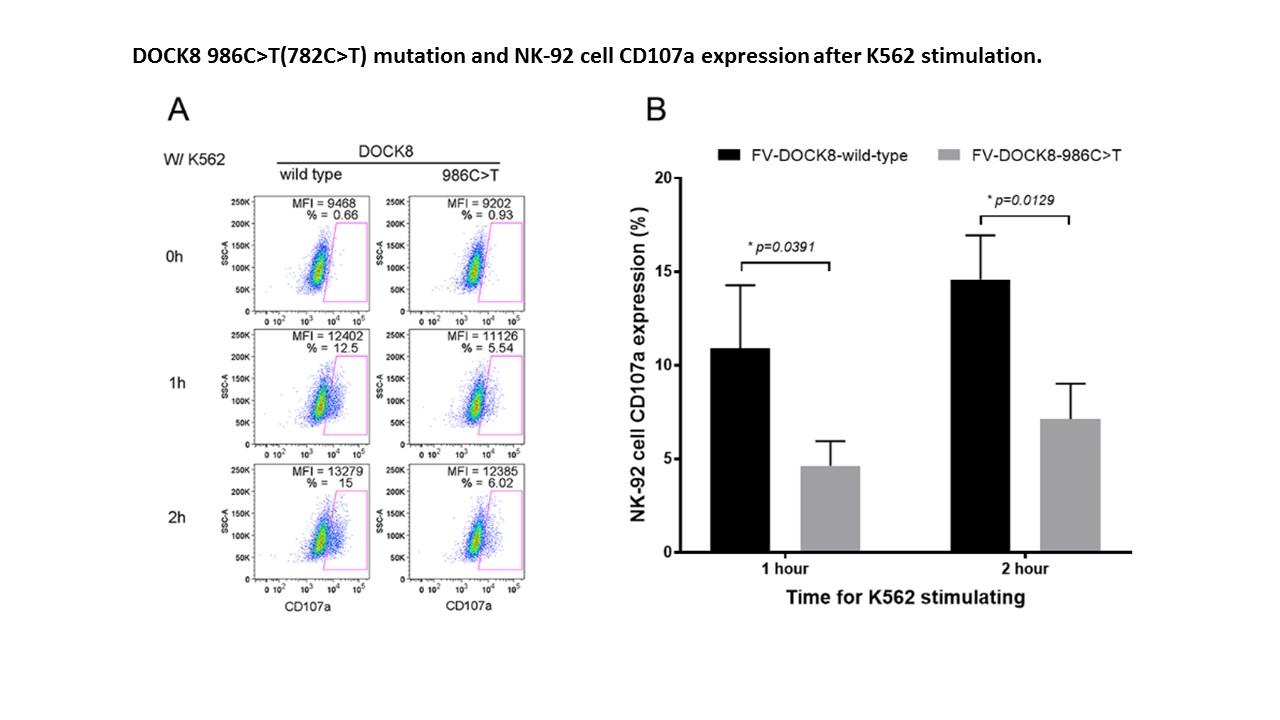Session Information
Session Type: Abstract Session
Session Time: 5:00PM-5:50PM
Background/Purpose: Cytokine storm syndrome (CSS), also known as macrophage activation syndrome (MAS) or secondary hemophagocytic lymphohistiocytosis (HLH), is a life threatening condition that commonly presents with unremitting fever and shock like multi-organ dysfunction (MOD). Laboratory studies show pancytopenia, elevated liver enzymes, elevated ferritin, and hemophagocytosis. Familial forms of HLH result from homozygous defects in genes involved in perforin mediated cytolysis by NK cells and CD8 T cells. As many as 30-40% of CSS patient cohorts studied have heterozygous defects in the same HLH genes resulting in decreased cytolytic function, prolonged interaction with antigen presenting cells, and subsequent increased pro-inflammatory cytokines resulting in MOD. Since NK cell dysfunction is common in CSS, there are likely other genes that contribute to CSS via decreased cytolysis. Using gene sequencing, mutations in potentially novel HLH genes present in 2 or more CSS patients were explored.
Methods: Pediatric and adult patients with CSS at UAB were screened for genetic mutations, potentially contributing to CSS, via whole genome sequencing or a commercial immunodeficiency exomic genetic panel of 207 genes. Four patients were noted to have mutations in the guanine nucleotide exchange factor DOCK8 critical to NK cell function. DOCK8 mutations from this CSS cohort, or wild-type (WT) sequence controls, were introduced exogenously into human NK-92 NK cell lines by foamy virus (FV) transduction. Alternatively, the endogenous NK-92 DOCK8 genes were cut and repaired to express WT sequence or patient derived DOCK8 mutations by CRISPR/Cas9 technology. WT and mutant DOCK8 expressing NK-92 cells were incubated with K562 target cells and compared for cytolytic activity, degranulation (CD107a), and cytokine [interferon-g (IFNg), tumor necrosis factor (TNF)] production by flow cytometry.
Results: Two CSS patients were identified with rare heterozygous DOCK8 mutations, and 2 others with CSS were noted to have the same DOCK8 polymorphism (c.187G >A, p.Asp63Asn) present in 12% of the population (Table). One of the rare mutations was missense (c.782C >T, p.Ala261Val – novel), and one was a splice acceptor variant (c.54-1G >T, 0.03%). The novel DOCK8 mutant consistently decreased NK cell lytic activity when introduced by either CRISPR/Cas9 (n=2) or FV (n=3, decreased by ~50% compared to WT, p=0.007) (Fig. 1). Similarly, the novel mutant decreased degranulation by >50% (n=3, p=0.013) (Fig. 2). During the incubation of the NK-92 cells with K562 targets, NK cells expressing the novel DOCK8 mutant increased expression of IFNg and TNF by >200% (p=0.019 & p=0.003, respectively). The DOCK8 polymorphism decreased lysis and degranulation to a lesser degree. The DOCK8 splicing mutation disrupted RNA splicing by an exon trapping assay and a novel assay developed in the lab.
Conclusion: Heterozygous mutations in DOCK8, a novel CSS associated gene, likely contribute to CSS pathology through a partial dominant-negative or hypomorphic effect resulting in decreased cytolysis and increased pro-inflammatory cytokine production.
 Table. DOCK8 rare mutations and polymorphisms identified in CSS patients.
Table. DOCK8 rare mutations and polymorphisms identified in CSS patients.
 Figure 1. Cytolytic activity of patient #1 DOCK8 missense mutation in NK-92 cells. NK-92 cells were transduced with WT or patient mutation DOCK8-expressing FV and incubated with K562 target cells. A. K562 lysis detected by near-IR fluorescence at 2 E:T ratios. B. N=3, means +/- SEMs.
Figure 1. Cytolytic activity of patient #1 DOCK8 missense mutation in NK-92 cells. NK-92 cells were transduced with WT or patient mutation DOCK8-expressing FV and incubated with K562 target cells. A. K562 lysis detected by near-IR fluorescence at 2 E:T ratios. B. N=3, means +/- SEMs.
 Figure 2. Degranulation of patient #1 DOCK8 missense mutation in NK-92 cells. NK-92 cells were transduced with WT or patient mutation DOCK8-expressing FV and incubated with K562 target cells. A. NK-92 cell degranulation detected by CD107a surface expression at 3 time points. B. N=3, means +/- SEMs.
Figure 2. Degranulation of patient #1 DOCK8 missense mutation in NK-92 cells. NK-92 cells were transduced with WT or patient mutation DOCK8-expressing FV and incubated with K562 target cells. A. NK-92 cell degranulation detected by CD107a surface expression at 3 time points. B. N=3, means +/- SEMs.
To cite this abstract in AMA style:
Zhang M, Cron R, Absher D, Atkinson P, Chatham W, Cron R. Characterization of DOCK8 as a Novel Gene Associated with Cytokine Storm Syndrome [abstract]. Arthritis Rheumatol. 2020; 72 (suppl 10). https://acrabstracts.org/abstract/characterization-of-dock8-as-a-novel-gene-associated-with-cytokine-storm-syndrome-2/. Accessed .« Back to ACR Convergence 2020
ACR Meeting Abstracts - https://acrabstracts.org/abstract/characterization-of-dock8-as-a-novel-gene-associated-with-cytokine-storm-syndrome-2/
